9.1 Genetic Analysis of Bacteria Requires Special Methods
Heredity in bacteria is fundamentally similar to heredity in more-complex organisms, but the bacterial haploid genome and the small size of bacteria (which makes observation of their phenotypes difficult) require different approaches and methods.
Bacterial Diversity
Prokaryotes are unicellular organisms that lack nuclear membranes and membrane-bounded cell organelles. For many years, biologists considered all prokaryotes to be related, but DNA sequence information now provides convincing evidence that prokaryotes are divided into at least two distinct groups: the archaea and the eubacteria. The archaea are a group of diverse prokaryotes that are frequently found in extreme environments, such as hot springs and at the bottoms of oceans. The eubacteria are the remaining prokaryotes, including most of the familiar bacteria. Although superficially similar in their cell structure, eubacteria and archaea are distinct in their genetic makeup, and the differences between them are as great as those between eubacteria and eukaryotes. In fact, the archaea are more similar to eukaryotes than to eubacteria in a number of molecular features and genetic processes. In this book, the term bacteria is generally used to refer to eubacteria.
Bacteria are extremely diverse and come in a variety of shapes and sizes. Some are rod shaped, whereas others are spherical. Most are much smaller than eukaryotic cells, but at least one species isolated from the gut of fish is almost 1 mm long and can be seen with the naked eye. Some bacteria are photosynthetic. Others produce stalks and spores, superficially resembling fungi.
Bacteria have long been considered simple organisms that lack much of the cellular complexity of eukaryotes. However, recent evidence points to a number of similarities and parallels in bacterial and eukaryotic structure. For example, a bacterial protein termed FtsZ, which plays an integral part in cell division, is structurally similar to eukaryotic tubulin proteins, which are subunits of microtubules and help segregate chromosomes in mitosis and meiosis (Chapter 2). Like eukaryotes, bacteria have proteins that help condense DNA. Other bacterial proteins function much as cytoskeletal proteins do in eukaryotes, helping to give bacterial cells shape and structure.
And, although bacteria don’t go through mitosis and meiosis, replication of the bacterial chromosome precedes binary fission, and there are bacterial processes that ensure that one copy of the chromosome is allocated to each cell.
Techniques for the Study of Bacteria
The culture and study of bacteria require special techniques. Microbiologists have defined the nutritional needs of a number of bacteria and developed culture media for growing them in the laboratory. Culture media typically contain a carbon source, essential elements such as nitrogen and phosphorus, certain vitamins, and other required ions and nutrients. Wild-type, or prototrophic, bacteria can use these simple ingredients to synthesize all the compounds that they need for growth and reproduction. A medium that contains only the nutrients required by prototrophic bacteria is termed minimal medium.
Mutant strains called autotrophs lack one or more enzymes necessary for synthesizing essential molecules and will grow only on medium supplemented with these essential molecules. For example, auxotrophic strains that are unable to synthesize the amino acid leucine will not grow on minimal medium but will grow on medium to which leucine has been added. Complete medium contains all the substances, such as the amino acid leucine, required by bacteria for growth and reproduction.
Cultures of bacteria are often grown in test tubes that contain sterile liquid medium (Figure 9.1a). A few bacteria are added to a tube, and they grow and divide until all the nutrients are used up or—more commonly—until the concentration of their waste products becomes toxic. Bacteria are also grown on petri plates (Figure 9.1b). Growth medium suspended in agar is poured into the bottom half of the petri plate, providing a solid, gel-like base for bacterial growth. In a process called plating, a dilute solution of bacteria is spread over the surface of an agar-filled petri plate. As each bacterium grows and divides, it gives rise to a visible clump of genetically identical cells (a colony). Genetically pure strains of the bacteria can be isolated by collecting bacteria from a single colony and transferring them to a new test tube or petri plate. The chief advantage of this method is that it allows one to isolate and count bacteria, which individually are too small to see without a microscope.

Microbiologists often study phenotypes that affect the appearance of the colony (Figure 9.2) or can be detected by simple chemical tests. Auxotrophs are commonly studied phenotypes. Suppose we want to detect auxotrophs that cannot synthesize leucine (leu− mutants). We first spread the bacteria on a petri plate containing medium that includes leucine; both prototrophs that have the leu+ allele and auxotrophs that have leu− allele will grow on it (Figure 9.3). Next, using a technique called replica plating, we transfer a few cells from each of the colonies on the original plate to two new replica plates: one plate contains medium to which leucine has been added; the other plate contains a medium lacking leucine. A medium that lacks an essential nutrient, such as the medium lacking leucine, is called a selective medium. The leu+ bacteria will grow on both media, but the leu− mutants will grow only on the selective medium supplemented by leucine, because they cannot synthesize their own leucine. Any colony that grows on medium that contains leucine but not on medium that lacks leucine consists of leu− bacteria. The auxotrophs that grow on the supplemented medium can then be cultured for further study.


The Bacterial Genome
Most bacterial genomes consist of a circular chromosome that contains a single DNA molecule several million base pairs (bp) in length (Figure 9.4). For example, the E. coli genome has approximately 4.6 million base pairs of DNA. However, some bacteria contain multiple chromosomes. For example, Vibrio cholerae, which causes cholera, has two circular chromosomes, and Rhizobium meliloti has three chromosomes. There are even a few bacteria that have linear chromosomes. Many bacterial chromosomes are organized efficiently. For example, more than 90% of the DNA in E. coli encodes proteins. In contrast, only about 1% of human DNA encodes proteins.

Plasmids
In addition to having a chromosome, many bacteria possess plasmids—small, usually circular DNA molecules. Some plasmids are present in many copies per cell, whereas others are present in only one or two copies. In general, plasmids carry genes that are not essential to bacterial function but that may play an important role in the life cycle and growth of their bacterial hosts. There are many different types of plasmids; E. coli alone is estimated to have more than 270 different naturally occurring plasmids. Some plasmids promote mating between bacteria; others contain genes that kill other bacteria. Plasmids are used extensively in genetic engineering (see Chapter 19), and some of them play a role in the spread of antibiotic resistance among bacteria.
Most plasmids are circular and several thousand base pairs in length, although plasmids consisting of several hundred thousand base pairs also have been found. Each plasmid possesses an origin of replication, a specific DNA sequence where DNA replication is initiated (see Chapter 2). The origin allows a plasmid to replicate independently of the bacterial chromosome (Figure 9.5). Episomes are plasmids that are capable of freely replicating and able to integrate into the bacterial chromosomes. The F (fertility) factor of E. coli (Figure 9.6) is an episome that controls mating and gene exchange between E. coli cells, as will be discussed in the next section.


CONCEPTS
Bacteria can be studied in the laboratory by growing them on defined liquid or solid medium. A typical bacterial genome consists of a single circular chromosome that contains several million base pairs. Some bacterial genes may be present on plasmids, which are small, circular DNA molecules that replicate independently of the bacterial chromosome.
 CONCEPT CHECK 1
CONCEPT CHECK 1Which is true of plasmids?
- They are composed of RNA.
- They normally exist outside of bacterial cells.
- They possess only a single strand of DNA.
- They contain an origin of replication.